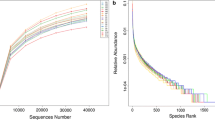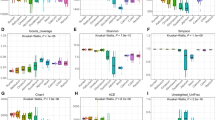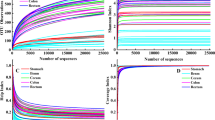Abstract
The bacterial community in mammalian gastrointestinal tract is abundant and complex. To date, little is known about the gut microbiota of wild boar. This study aimed to investigate the fecal bacterial diversity of wild boar and compare with commercial pig and domestic native pig. The diet composition showed that the diets of wild boar, commercial pig and domestic native pig were different from each other. More than 1,760,000 quality-filtered sequences were obtained, and the results revealed distinct compositions and diversity of fecal microbiota in three groups. PCoA and NMDS analyses showed that fecal bacterial communities of wild boar, commercial pig and domestic native pig formed distinctly different clusters. Although the three groups shared a large size of OTUs comprising a core microbiota community, a strong distinction existed at family and genus levels. Ruminococcaceae, Prevotellaceae and Christensenellaceae were more abundant in the feces of wild boar than in domestic native pig and commercial pig. At the genus level, the proportion of unidentified Christensenellaceae was remarkably higher in wild boar group, while commercial pig and domestic native pig group had a higher abundance of Streptococcus and Lactobacillus. Tax4Fun predictions of metagenome function showed statistically significant differences in the functions of fecal microbiota in three groups. There were more bacteria genes with amino acid metabolism, cell growth and death, cell motility, energy metabolism, immune system and environmental adaptation observed in wild boar feces, while commercial pig feces contained more bacteria genes with carbohydrate metabolism, drug resistance, aging, infectious diseases, lipid metabolism, endocrine and metabolic diseases. These results indicated that the fecal microbial ecosystem of the wild boar is significantly different from that of domestic native pig and commercial pig, suggesting that diet is an important factor leading to differences in bacterial abundance and diversity in feces.








Similar content being viewed by others
References
Alain B, Pajarillo E, Chae J-P, Balolong MP et al (2014) Assessment of fecal bacterial diversity among healthy piglets during the weaning transition. J Gen Appl Microbiol 60:140–146. https://doi.org/10.2323/jgam.60.140
Bengmark S (2013) Gut microbiota, immune development and function. Pharmacol Res 69:87–113
Canfora EE, Jocken JW, Blaak EE (2015) Short-chain fatty acids in control of body weight and insulin sensitivity. Nat Rev Endocrinol 11:577–591
Caporaso JG, Kuczynski J, Stombaugh J et al (2010) QIIME allows analysis of high-throughput community sequencing data. Nat Methods 7:335–336
Cummings JH (1981) Short chain fatty acids in the human colon. Gut 22:763–779
D’Souza DN, Pethick DW, Dunshea FR et al (2003) Nutritional manipulation increases intramuscular fat levels in the longissimus muscle of female finisher pigs. Aust J Agric Res. https://doi.org/10.1071/AR03009
Daniel H, Gholami AM, Berry D et al (2014) High-fat diet alters gut microbiota physiology in mice. ISME J. https://doi.org/10.1038/ismej.2013.155
Duncan SH, Louis P, Thomson JM, Flint HJ (2009) The role of pH in determining the species composition of the human colonic microbiota. Environ Microbiol. https://doi.org/10.1111/j.1462-2920.2009.01931.x
Edgar RC, Haas BJ, Clemente JC et al (2011) UCHIME improves sensitivity and speed of chimera detection. Bioinformatics. https://doi.org/10.1093/bioinformatics/btr381
Fang CL, Sun H, Wu J et al (2014) Effects of sodium butyrate on growth performance, haematological and immunological characteristics of weanling piglets. J Anim Physiol Anim Nutr (Berl). https://doi.org/10.1111/jpn.12122
Fouhse JM, Zijlstra RT, Willing BP (2016) The role of gut microbiota in the health and disease of pigs. Anim Front. https://doi.org/10.2527/af.2016-0031
Gresse R, Chaucheyras-Durand F, Fleury MA et al (2017) Gut microbiota dysbiosis in postweaning piglets: understanding the keys to health. Trends Microbiol 25:851–873
Hayashi H, Shibata K, Sakamoto M et al (2007) Prevotella copri sp. nov. and Prevotella stercorea sp. nov., isolated from human faeces. Int J Syst Evol Microbiol 57:941–946. https://doi.org/10.1099/ijs.0.64778-0
Henning PH, Horn CH, Steyn DG et al (2010) The potential of Megasphaera elsdenii isolates to control ruminal acidosis. Anim Feed Sci Technol 157:13–19. https://doi.org/10.1016/j.anifeedsci.2009.12.011
Heo JM, Opapeju FO, Pluske JR, Kim JC, Hampson DJ, Nyachoti CM (2013) Gastrointestinal health and function in weaned pigs: a review of feeding strategies to control post-weaning diarrhoea without using in-feed antimicrobial compounds. J Anim Physiol Anim Nutr 97:207–237
Högberg A, Lindberg JE, Leser TD, Wallgren P (2004) Influence of cereal non-starch polysaccharides on ileo-caecal and rectal microbial populations in growing pigs. Acta Vet Scand 45:1–2. https://doi.org/10.1186/1751-0147-45-87
Houghton D, Stewart CJ, Day CP, Trenell M (2016) Gut microbiota and lifestyle interventions in NAFLD. Int J Mol, Sci
Isaacson R, Kim HB (2012) The intestinal microbiome of the pig. Anim Health Res Rev 13:100–109
Ivarsson E, Roos S, Liu HY, Lindberg JE (2014) Fermentable non-starch polysaccharides increases the abundance of Bacteroides–Prevotella–Porphyromonas in ileal microbial community of growing pigs. Animal 8:1777–1787. https://doi.org/10.1017/s1751731114001827
Jiang YZ, Zhu L, Li XW, Si T (2011) Evaluation of the Chinese indigenous pig breed Dahe and crossbred Dawu for growth and carcass characteristics, organ weight, meat quality and intramuscular fatty acid and amino acid composition. Animal. https://doi.org/10.1017/S1751731111000425
Ke S, Fang S, He M et al (2019) Age-based dynamic changes of phylogenetic composition and interaction networks of health pig gut microbiome feeding in a uniformed condition. BMC Vet Res. https://doi.org/10.1186/s12917-019-1918-5
Kim HB, Isaacson RE (2015) The pig gut microbial diversity: understanding the pig gut microbial ecology through the next generation high throughput sequencing. Vet Microbiol 177:242–251
Kim YS, Milner JA (2018) Dietary modulation of colon cancer risk. J Nutr 137:2576S–2579S. https://doi.org/10.1093/jn/137.11.2576s
Kim HB, Borewicz K, White BA et al (2011) Longitudinal investigation of the age-related bacterial diversity in the feces of commercial pigs. Vet Microbiol 153:124–133. https://doi.org/10.1016/j.vetmic.2011.05.021
Kim JC, Hansen CF, Mullan BP, Pluske JR (2012) Nutrition and pathology of weaner pigs: nutritional strategies to support barrier function in the gastrointestinal tract. Anim Feed Sci Technol 173:3–16
Koh A, De Vadder F, Kovatcheva-Datchary P, Bäckhed F (2016) From dietary fiber to host physiology: short-chain fatty acids as key bacterial metabolites. Cell 165:1332–1345
Lamendella R, Santo Domingo JW, Ghosh S et al (2011) Comparative fecal metagenomics unveils unique functional capacity of the swine gut. BMC Microbiol 11:103
Lau SKP, Teng JLL, Chiu TH et al (2018) Differential microbial communities of omnivorous and herbivorous cattle in Southern China. Comput Struct Biotechnol J. https://doi.org/10.1016/j.csbj.2018.02.004
Leser TD, Amenuvor JZ, Jensen TK et al (2002) Culture-independent analysis of gut bacteria: the pig gastrointestinal tract microbiota revisited. Appl Environ Microbiol 68:673–690. https://doi.org/10.1128/AEM.68.2.673-690.2002
LiGang L, ShuMin Z, ZhaoHua L et al (2009) Comparative study on growing-finishing performance and meat quality of different hybrid combinations in pigs. Anim Husb Feed Sci 1:4–13
Liu HY, Roos S, Jonsson H et al (2015) Effects of Lactobacillus johnsonii and Lactobacillus reuteri on gut barrier function and heat shock proteins in intestinal porcine epithelial cells. Physiol Rep. https://doi.org/10.14814/phy2.12355
Manichanh C, Rigottier-Gois L, Bonnaud E et al (2006) Reduced diversity of faecal microbiota in Crohn’s disease revealed by a metagenomic approach. Gut. https://doi.org/10.1136/gut.2005.073817
Muñiz Pedrogo DA, Jensen MD, Van Dyke CT et al (2018) Gut microbial carbohydrate metabolism hinders weight loss in overweight adults undergoing lifestyle intervention with a volumetric diet. Mayo Clin Proc 93:1104–1110. https://doi.org/10.1016/j.mayocp.2018.02.019
Ogata H, Goto S, Sato K et al (1999) KEGG: kyoto encyclopedia of genes and genomes. Nucleic Acids Res 28:27–30
Olivares A, Daza A, Rey AI, Lopez-Bote CJ (2009) Interactions between genotype, dietary fat saturation and vitamin A concentration on intramuscular fat content and fatty acid composition in pigs. Meat Sci. https://doi.org/10.1016/j.meatsci.2008.11.006
Pajarillo EAB, Chae JP, Balolong MP et al (2014) Pyrosequencing-based analysis of fecal microbial communities in three purebred pig lines. J Microbiol. https://doi.org/10.1007/s12275-014-4270-2
Perevoyko ZA (2015) Comparative evaluation of fattening, slaughter and meat qualities of purebred and hybrid swine. Modern Appl Sci. https://doi.org/10.5539/mas.v9n8p344
Pluske JR, Turpin DL, Kim JC (2018) Gastrointestinal tract (gut) health in the young pig. Anim Nutr 4:187–196
Qin J, Li Y, Cai Z et al (2012) A metagenome-wide association study of gut microbiota in type 2 diabetes. Nature 490:55–60. https://doi.org/10.1038/nature11450
Rossi R, Pastorelli G, Cannata S, Corino C (2010) Recent advances in the use of fatty acids as supplements in pig diets: a review. Anim Feed Sci, Technol
Sanz M, Flores A, Lopez-Bote CJ (2000) The metabolic use of energy from dietary fat in broilers is affected by fatty acid saturation. Br Poult Sci. https://doi.org/10.1080/00071660086411
Scher JU, Ubeda C, Artacho A et al (2015) Decreased bacterial diversity characterizes the altered gut microbiota in patients with psoriatic arthritis, resembling dysbiosis in inflammatory bowel disease. Arthritis Rheumatol. https://doi.org/10.1002/art.38892
Schley L, Roper TJ (2003) Diet of wild boar Sus scrofa in Western Europe, with particular reference to consumption of agricultural crops. Mamm Rev 33:43–56. https://doi.org/10.1046/j.1365-2907.2003.00010.x
Senghor B, Sokhna C, Ruimy R, Lagier JC (2018) Gut microbiota diversity according to dietary habits and geographical provenance. Hum Microbiome J 7:1–9
Smith PM, Howitt MR, Panikov N et al (2013) The microbial metabolites, short-chain fatty acids, regulate colonic T reg cell homeostasis. Science. https://doi.org/10.1126/science.1241165
Sommer F, Anderson JM, Bharti R et al (2017a) The resilience of the intestinal microbiota influences health and disease. Nat Rev, Microbiol
Sommer F, Rühlemann MC, Bang C et al (2017b) Microbiomarkers in inflammatory bowel diseases: caveats come with caviar. Gut. https://doi.org/10.1136/gutjnl-2016-313678
Song D, Peng Q, Chen Y et al (2017) Altered gut microbiota profiles in sows and neonatal piglets associated with Porcine epidemic diarrhea virus infection. Sci Rep. https://doi.org/10.1038/s41598-017-17830-z
Šprysl M, Stupka R, Čítek J (2018) Genotype impact on the economy of production performance in pigs. Agric Econ (Zemědělská Ekon). https://doi.org/10.17221/5085-agricecon
Stearns JC, Lynch MDJ, Senadheera DB et al (2011) Bacterial biogeography of the human digestive tract. Sci Rep 1:170. https://doi.org/10.1038/srep00170
Stenman LK, Burcelin R, Lahtinen S (2016) Establishing a causal link between gut microbes, body weight gain and glucose metabolism in humans—towards treatment with probiotics. Benef Microbes 7:11–22. https://doi.org/10.3920/BM2015.0069
Sullivan Å, Edlund C, Nord CE (2002) Effect of antimicrobial agents on the ecological balance of human microflora. Lancet Infect Dis 1:101–114. https://doi.org/10.1016/s1473-3099(01)00066-4
Thomas F, Hehemann JH, Rebuffet E et al (2011) Environmental and gut bacteroidetes: the food connection. Front Microbiol 2:93. https://doi.org/10.3389/fmicb.2011.00093
Tian X, Wu W, Yu Q et al (2017) Bacterial diversity analysis of pork longissimus lumborum following long term ohmic cooking and water bath cooking by amplicon sequencing of 16S rRNA gene. Meat Sci. https://doi.org/10.1016/j.meatsci.2016.09.007
Turnbaugh PJ, Ley RE, Mahowald MA et al (2006) An obesity-associated gut microbiome with increased capacity for energy harvest. Nature 444:1127–1131. https://doi.org/10.1038/nature05414
Viaud S, Saccheri F, Mignot G et al (2013) The intestinal microbiota modulates the anticancer immune effects of cyclophosphamide. Science 342:971–976. https://doi.org/10.1126/science.1240537
Wang HF, Zhu WY, Yao W, Liu JX (2007a) DGGE and 16S rDNA sequencing analysis of bacterial communities in colon content and feces of pigs fed whole crop rice. Anaerobe. https://doi.org/10.1016/j.anaerobe.2007.03.001
Wang Q, Garrity GM, Tiedje JM, Cole JR (2007b) Naïve Bayesian classifier for rapid assignment of rRNA sequences into the new bacterial taxonomy. Appl Environ Microbiol 73:5261–5267. https://doi.org/10.1128/AEM.00062-07
Yang L, Bian G, Su Y, Zhu W (2014) Comparison of faecal microbial community of lantang, bama, erhualian, meishan, xiaomeishan, duroc, landrace, and yorkshire sows. Asian-Aust J Anim Sci 27:898–906. https://doi.org/10.5713/ajas.2013.13621
Zhang SH, Shen LY, Luo J et al (2015) Analysis of carcass and meat quality traits and nutritional values of hybrid wild boars under different crossing systems. Genet Mol Res 14:2608–2616. https://doi.org/10.4238/2015.March.30.20
Zhao W, Wang Y, Liu S et al (2015) The dynamic distribution of porcine microbiota across different ages and gastrointestinal tract segments. PLoS ONE 10:e0117441. https://doi.org/10.1371/journal.pone.0117441
Zhao JB, Liu P, Huang CF et al (2018) Effect of wheat bran on apparent total tract digestibility, growth performance, fecal microbiota and their metabolites in growing pigs. Anim Feed Sci Technol 239:14–26. https://doi.org/10.1016/j.anifeedsci.2018.02.013
Acknowledgements
This work was supported by National Natural Science Foundation of China (NSFC, Project No. 31560449 and N0.31760457), the National Key Research and Development Program of China (2017YFD0400503-3) and the State Key Laboratory of Food Science and Technology Nanchang University (Project No. SKLF-ZZA-201610).
Author information
Authors and Affiliations
Corresponding author
Additional information
Communicated by Erko Stackebrandt.
Publisher's Note
Springer Nature remains neutral with regard to jurisdictional claims in published maps and institutional affiliations.
Electronic supplementary material
Below is the link to the electronic supplementary material.
Rights and permissions
About this article
Cite this article
Huang, J., Zhang, W., Fan, R. et al. Composition and functional diversity of fecal bacterial community of wild boar, commercial pig and domestic native pig as revealed by 16S rRNA gene sequencing. Arch Microbiol 202, 843–857 (2020). https://doi.org/10.1007/s00203-019-01787-w
Received:
Revised:
Accepted:
Published:
Issue Date:
DOI: https://doi.org/10.1007/s00203-019-01787-w




